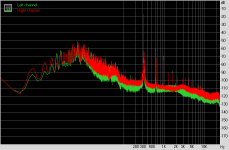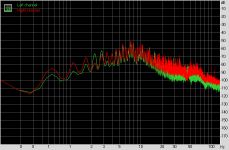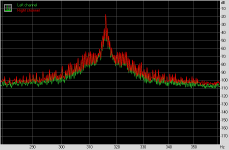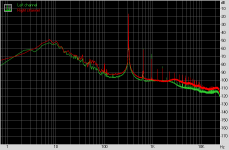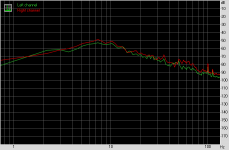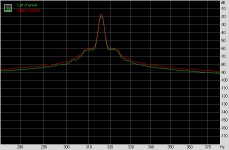Member
Joined 2019
Well, I thing I have said almost everything.. BTW, what is your turntable?I have just started my Lp digitising and if I can achieve anywhere near your posted file I will be well pleased...
Looking forward to your further revelations...
Member
Joined 2019
Fine.. I think that in the case of any pivoted arm the most important think before digital editing if to adjust as well as possible the antiskating force.Well Tempered Classic..... owned since new so... hmm... 30 years plus ! recently refurbished with custom bearing replacement, new belt and fluids...
Koetsu Rosewood, Grado Gold, At95E...RJM Emerald Phono stage and either Adobe audition 3.1 ;-) or Audacity.
Noise reduction (NR) is the most discussed and questioned part of the digital editing procedure. The main source of the noise are the irregularities in the grooves surface, which start from a given production level and increase with the use of the record.
On pre-digital material I find tape noise is often significantly above vinyl noise. I also would question you comment on noise increasing with use. If anything, when played with an undamaged stylus groove noise is likely to reduce with playing as there is a gentle linishing. The tell tale is if the noise level drops between tracks then it's tape noise.
What would be helpful to people is a sequence of examples.
1. Raw rip
2. Rip after declick
3. Rip after declick and denoise
4. Rip after final polish
Then people can compare and for those new to ripping decide just how far they want to go.
Member
Joined 2019
What would be helpful to people is a sequence of examples.
1. Raw rip
2. Rip after declick
3. Rip after declick and denoise
4. Rip after final polish
Then people can compare and for those new to ripping decide just how far they want to go.
I can accomplish a comparison of this type, by using of some carefully selected and not too long raw rip. I say "carefully selected", because, for example, a piece with a very few clicks could not expose fully the benefits of declick, while one with too much could be a too obvious example.
The benefit of removing the very low frequencies could be not easily detected with speaker systems going as low as 40 Hz. In fact, a speaker like this makes almost the same job as my low filtering, but for Fo = 40 Hz instead of 30 or 25 or 20 Hz. A speaker has to go really down to 20 Hz in order to reproduce the second and third harmonics of - say - the resonance frequency of 13 Hz.
The correction of the cartridge/preamp frequency response could make some people to dislike it because, in my case, it lowers with 1-2 dB certain region of mid/bass frequencies, namely 60 - 300 Hz. Some people prefer the enhanced bass instead of the correct bass..
Given all the above, I will make a comparison FLAC file of this type. Till then, I remind my existing demo file
YouTube
which starts with a short comparison between a raw rip and a fully edited one. Other old materials close to the subject:
YouTube
YouTube
A lot of hardware data in these materials is quite obsolete.
1. Raw rip
2. Rip after declick
3. Rip after declick and denoise
4. Rip after final polish
A couple of software tests that are interesting, looking at what was removed by the declicker can be interesting and building a file of ticks and pops and adding it to a perfectly clean CD rip and seeing how well the declicker does on it.
I wish I had the bandwidth to revive the open source project based on that paper on forensic restoration of audio that I posted a long time ago. The results especially of the recursive algorithm to fill the gaps were spectacular.
I wish I had the bandwidth to revive the open source project based on that paper on forensic restoration of audio that I posted a long time ago. The results especially of the recursive algorithm to fill the gaps were spectacular.
I wish I had the coding skills to help. I almost thought of calling up Cedar and asking if they would do a 'home' version of their appliance as sweetwater have that bit of the market currently sewn up.
Member
Joined 2019
Test 5 (as we say 'Take Five')
After a suggestion of billshurv, I post Test 5
A comparison of an original unedited recording from a Soviet Jazz LP with 4 edited versions, where various types of interventions are gradually applied. Each part has a duration of exactly 60 s.
00:00 The original record, WAV 48 kHz 32 bit floating point
01:00 The same record after below 30 Hz removal
02:00 The same record after below 30 Hz removal and Clicks repair
03:00 The same record after below 30 Hz removal, Clicks repair and Noise reduction
04:00 The same record after below 30 Hz removal, Clicks repair, Noise reduction and Cartridge equalization
05:00 End of file
The vinyl:
Инструментальное Трио Леонида Чижика
Мелодия 33 С 60 05777-8
СССР, 1975
Вступление - Л. Чижик
The YouTube file:
YouTube
The FLAC file:
Jazz Trio Leonid Chizhik All 5.flac - Google Drive
After a suggestion of billshurv, I post Test 5
A comparison of an original unedited recording from a Soviet Jazz LP with 4 edited versions, where various types of interventions are gradually applied. Each part has a duration of exactly 60 s.
00:00 The original record, WAV 48 kHz 32 bit floating point
01:00 The same record after below 30 Hz removal
02:00 The same record after below 30 Hz removal and Clicks repair
03:00 The same record after below 30 Hz removal, Clicks repair and Noise reduction
04:00 The same record after below 30 Hz removal, Clicks repair, Noise reduction and Cartridge equalization
05:00 End of file
The vinyl:
Инструментальное Трио Леонида Чижика
Мелодия 33 С 60 05777-8
СССР, 1975
Вступление - Л. Чижик
The YouTube file:
YouTube
The FLAC file:
Jazz Trio Leonid Chizhik All 5.flac - Google Drive
I used my HD600 headphone to have a rough listening of Youtube video. Clearly, unedited version beats every edited versions. The equalized version may come the 2nd because it got a lift in bass areas. However, the equalized version lacks the openness and natural flowing of music of unedited version. I will download the Flac version of the rip when I get home to further confirm my thought.
Personally, I never like Russian LPs. They may have wonderful contents, but sonically, it is not too great. I would also suggest to rip at 96 kHz.
Personally, I never like Russian LPs. They may have wonderful contents, but sonically, it is not too great. I would also suggest to rip at 96 kHz.
Last edited:
04:00 The same record after below 30 Hz removal, Clicks repair, Noise reduction and Cartridge equalization
05:00 End of file
What do you mean by cartridge equalization? RIAA? It would be difficult to evaluate processes fairly with no equalization thought there are good reasons to declick before RIAA.
Member
Joined 2019
What do you mean by cartridge equalization? RIAA? It would be difficult to evaluate processes fairly with no equalization.
I have explained in detail what I mean, so I refuse any further explanations. Better ask some producers of high end phono preamps what they mean when they present a number of selectable alternative input capacitances and impedances.
Member
Joined 2019
A question:
If I knock every 1 second on the table and record the sound, may I expect to find a peak of 1 Hz in the frequency analysis of my recording?
You are looking in the wrong place. Play a record with a 3,000Hz test tone. Knock on the turntable every 1 second as you say, but use your frequency analysis tools to look at the spectral purity centered around 3,000Hz, not at what's happening below 20Hz.
Ray K
A question:
If I knock every 1 second on the table and record the sound, may I expect to find a peak of 1 Hz in the frequency analysis of my recording?
If you use a high resolution FFT, yes, you may expect to find the 1Hz peak everywhere.
Like the 0.55Hz from the large eccentricity on this test LP (Test track 315Hz 12dBu lateral. FFT size 1M)
George
Attachments
If you use a high resolution FFT,
Same recording but now FFT size 64k
George
Attachments
Member
Joined 2019
You are looking in the wrong place. Play a record with a 3,000Hz test tone. Knock on the turntable every 1 second as you say, but use your frequency analysis tools to look at the spectral purity centered around 3,000Hz, not at what's happening below 20Hz.
Ray K
I have done this many times, not with "1 Hz knocks", naturally, but with the disk eccentricity and/or vertical warps "knocks". As I wrote before, it seems that we did had some misunderstanding about the use of the word "frequency" for the effects of the eccentricity of 1.8 s period = 0.555 Hz "frequency" and the presence of a 0.555 Hz frequency in the sound spectrum.
I saw the nice spectra of gpapag and I am glad to see that the 0.555 Hz in the sense I understood it are present with an intensity nearly -70 dB below that of the principal 315 Hz. That's what I expected for the 0.555 Hz - to be really insignificant as a spectrum component.
At least for me, the misunderstanding is over and leaves to me only with a shadow of insult due to the explanations of various trivial things by some people (like the term of "frequency modulation"). But this is not important..
Last edited:
Member
Joined 2019
Thank you for the materials, George. I will not repeat here my comments to Ray K, they are just above. But I am very interested on your frequency analysis software. My Adobe Audition one allows FFT sizes up to 65536. Can you tell me which software you use? Χαιρετώ!If you use a high resolution FFT, yes, you may expect to find the 1Hz peak everywhere.
Like the 0.55Hz from the large eccentricity on this test LP (Test track 315Hz 12dBu lateral. FFT size 1M)
George
Member
Joined 2019
I will repeat my view on our 0.55 Hz misunderstanding in order to discuss a detail related to minimizing eccentricity.
The talk started in the sub-thread related to removing the very low frequencies. So, I was thinking clearly from this point of view. For me, the modulation group 3000 ± A(k) k 0.55 Hz (where A(k) depend on the eccentricity level) consisted of the frequencies in Hz:
< etc. ... , 2998.90 , 2999.45 , 3000.00 , 3000.55 , 3001.1 , ... etc. >
where I did not see nothing else, although 0.55 Hz is a factor of the modulation. In the same sense I would usually thing of an FM signal of a 100.4 MHz station as a 100.4 MHz signal, and not as a 100.4 Hz ± all the modulated audio frequencies in a 15 kHz range (if mono).
Now about the eccentricity minimization. Even if we succeed to bring eccentricity to 0, it still may exist, in the case of warped disks. Quite roughly, a mild warp of 1 mm at R = 145 mm forms a right triangle with a hypotenuse of 145 mm, one cathetus of 1 mm and another cathetus of 144.9965 mm. An eccentricity of 0.0035 mm - really very low. But if the warp starts at R = 90 and is 2 mm high, the 'eccentricity' rises to 0.036 mm - again low, but not negligible. More severely and more "densely" warped disks could cause displacement peaks up to 0.1 mm.
In this case we have displacement frequencies 0.55 + multiples of 0.55.
The mentioned values are quite low, but indicate that suppressing of the warps by use of central and peripheral stabilizers, in addition to other benefits, reduce the effect of "warps eccentricity".
The talk started in the sub-thread related to removing the very low frequencies. So, I was thinking clearly from this point of view. For me, the modulation group 3000 ± A(k) k 0.55 Hz (where A(k) depend on the eccentricity level) consisted of the frequencies in Hz:
< etc. ... , 2998.90 , 2999.45 , 3000.00 , 3000.55 , 3001.1 , ... etc. >
where I did not see nothing else, although 0.55 Hz is a factor of the modulation. In the same sense I would usually thing of an FM signal of a 100.4 MHz station as a 100.4 MHz signal, and not as a 100.4 Hz ± all the modulated audio frequencies in a 15 kHz range (if mono).
Now about the eccentricity minimization. Even if we succeed to bring eccentricity to 0, it still may exist, in the case of warped disks. Quite roughly, a mild warp of 1 mm at R = 145 mm forms a right triangle with a hypotenuse of 145 mm, one cathetus of 1 mm and another cathetus of 144.9965 mm. An eccentricity of 0.0035 mm - really very low. But if the warp starts at R = 90 and is 2 mm high, the 'eccentricity' rises to 0.036 mm - again low, but not negligible. More severely and more "densely" warped disks could cause displacement peaks up to 0.1 mm.
In this case we have displacement frequencies 0.55 + multiples of 0.55.
The mentioned values are quite low, but indicate that suppressing of the warps by use of central and peripheral stabilizers, in addition to other benefits, reduce the effect of "warps eccentricity".
Last edited:
Member
Joined 2019
What do you mean by cartridge equalization? RIAA? It would be difficult to evaluate processes fairly with no equalization thought there are good reasons to declick before RIAA.
Please, ignore my previous answer. I have explained what I mean by cartridge equalization in another thread, so I will do this here too. But I am sure it is not something new for you.
The couple cartridge/preamp is supposed to provide a flat frequency response within 20 - 20000 Hz. For a number of reasons, some residing in the preamp, other - in the cartridge and third - in their "match", the measured response is not quite flat, but exposes some variations, say within ±2 dB. My cartridge equalization step corrects these variations to a level of ±0.2 dB. I do this by use of the Adobe Audition Graphic Equalizer in his 20 bands version. As long as the measuring disk test frequencies do not coincide always with those of the AA Equalizer, I have to apply some interpolations in certain cases.
I use the free version of RMAACan you tell me which software you use? Χαιρετώ!
RightMark Audio Analyzer. Products. Audio Rightmark
and leaves to me only with a shadow of insult due to the explanations of various trivial things by some people (like the term of "frequency modulation"). But this is not important..
There was no insult in the posts you’ve received.
The question is why one posts in an open technical forum if not for to communicate with people who don’t know him.
George
- Status
- This old topic is closed. If you want to reopen this topic, contact a moderator using the "Report Post" button.
- Home
- Source & Line
- Analogue Source
- Editing of digitized vinyl music - Pros and Cons
